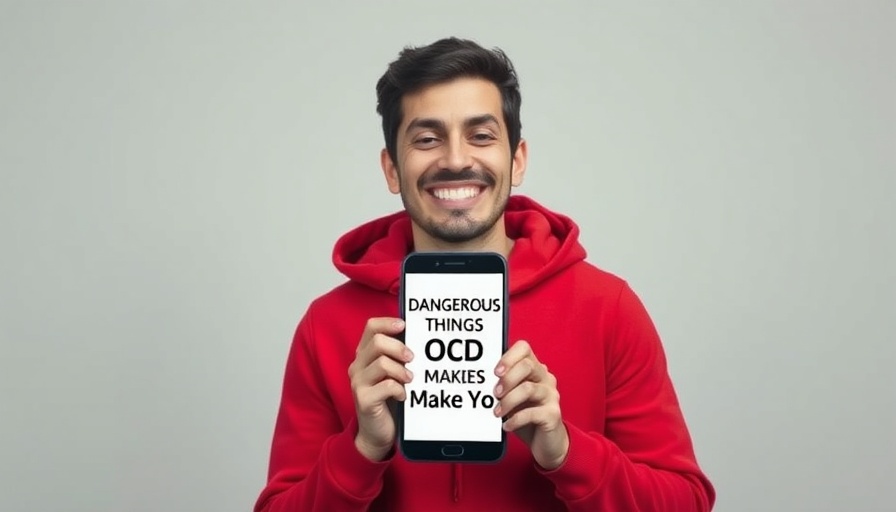
Understanding the Impact of Self-Harm Behaviors
Self-harm behaviors are a rarely discussed yet crucial aspect of mental health, particularly for those experiencing obsessive-compulsive disorder (OCD). Individuals with OCD may engage in self-harm as a misguided attempt to cope with overwhelming emotions and intrusive thoughts. Unfortunately, self-harm often stems from an internal belief that one deserves punishment for their thoughts and feelings, leading them to actions that provide only temporary relief. This misguided logic reinforces feelings of shame and guilt, perpetuating a cycle of pain.
In 'This OCD Compulsion Is Rarely Discussed', the discussion dives into the sensitive topic of self-harm behaviors associated with OCD, prompting us to explore key insights and implications for mental health education.
Why Do People Self-Harm?
The motivating factor behind self-harming behaviors is often an intense anxiety that becomes too difficult to manage. For some, the act of hurting themselves can seem like a way to regain control over their emotions, even if it is only fleeting. Many report that these behaviors arise from a desire to escape the grip of intrusive thoughts—obsessive thoughts that can feel all-consuming.
In reality, self-harming does not teach resilience or coping; instead, it often serves to reinforce negative thought patterns. By punishing themselves physically, individuals do not address the underlying issues at hand, which can include trauma, perfectionism, or anxiety disorders. This highlights a need for compassion and understanding in the discourse surrounding mental health.
Overcoming Compulsions Associated with Self-Harm
Breaking free from the cycle of self-harm is essential for those experiencing OCD. Cognitive Behavioral Therapy (CBT) is one of the most effective treatments that can help individuals understand their compulsions and develop healthier coping mechanisms. Through techniques like Exposure and Response Prevention (ERP), practitioners guide patients to confront their fears without resorting to self-harming behaviors. Alongside therapy, practicing mindfulness and relaxation techniques can play a pivotal role in managing anxiety and stress levels, making it easier to navigate the turbulent waters of intrusive thoughts.
Cultivating a Culture of Support
For many, seeking treatment can be daunting due to the stigma surrounding mental illness. It’s essential to create safe spaces where individuals feel comfortable discussing their mental health challenges. Support groups can serve as a beacon of hope for those struggling with OCD and self-harm, allowing them to connect with others who understand their struggles. This sense of community can diminish feelings of isolation that often exacerbate mental health challenges.
Practical Techniques for Self-Care
Implementing self-care practices is vital for those dealing with OCD and anxiety. Grounding techniques, such as deep breathing exercises and progressive muscle relaxation, can provide immediate relief in moments of distress. Visualization and positive affirmations also foster a more nurturing inner dialogue, which is essential for mental wellness.
Recognizing intrusive thoughts for what they are—unwanted and not reflective of reality—can help individuals diminish the weight these thoughts carry. Regular practice of perception-shifting techniques, such as cognitive restructuring, empowers individuals to challenge and reframe their anxious thoughts and feelings.
Empowering Change: The Role of Mental Health Education
Education plays a critical role in dismantling the stigma associated with OCD and self-harm. Awareness campaigns and mental health education initiatives can help the public understand the complexities of these issues. By learning about common misconceptions surrounding mental illness, society can foster an environment that encourages dialogue and drives individuals to seek help.
Ultimately, empowering those who struggle with OCD and self-harm through education and understanding is crucial. It’s about balancing knowledge with compassion, and offering hope where it is often in short supply.
Final Thoughts: Breaking the Cycle
In conclusion, self-harming behaviors associated with OCD and anxiety serve as manifestations of deeper psychological struggles. Understanding these behaviors, alongside effective treatment options like therapy, can help individuals break free from the shackles of guilt and shame. The journey to recovery is not linear, but with resilience, the right support, and determination, individuals can learn to live fulfilling lives beyond the confines of their mental illness. If you resonate with these challenges, know that resources and support are available. Reaching out for help is a courageous first step toward healing.
 Add Row
Add Row  Add
Add 




Write A Comment